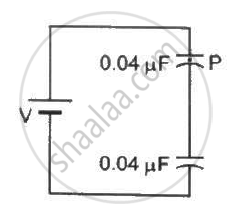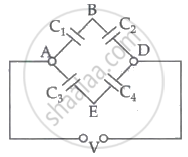Advertisements
Advertisements
प्रश्न
Answer the following question.
The magnitude of the electric field (in NC – 1) in a region varies with the distance r(in m) as
E = 10r + 5
By how much does the electric potential increase in moving from point at r = 11 m to a point at r = 10 m.
उत्तर
point A be given at r = 1 m, point B be given at r = 10 m
VA = potential at A
VB = potential at B
The relation between the electric field and potential difference is given by the relation,
`V_B - V_A = -int_A^B vec"E". d vec"r"`
`V_B-V_A = - int_1^10 (10r+5).dr`
= `-[(10r^2)/2 + 5r]_1^10`
= `-[((10(10)^2)/2 + 5xx 10) - ((10(1)^2)/2 + 5xx1)]`
= `-[550-10]`
= -540 V
APPEARS IN
संबंधित प्रश्न
The particle P shown in figure has a mass of 10 mg and a charge of −0⋅01 µC. Each plate has a surface area 100 cm2 on one side. What potential difference V should be applied to the combination to hold the particle P in equilibrium?

Show that electric potential at a point P, at a distance 'r' from a fixed point charge Q, is given by:
`v=(1/(4pi∈_0))Q/r`.
Electric potential energy of two point charges q and q0 is ________.
A cube of metal is given a positive charge Q. For this system, which of the following statements is true?
From a point charge, there is a fixed point A. At A, there is an electric field of 500 V/m and potential difference of 3000 V. Distance between point charge and A will be ______.
An electric dipole of moment `vec"p"` is placed in a uniform electric field `vec"E"`. Then ______.
- the torque on the dipole is `vec"p" xx vex"E"`
- the potential energy of the system is `vec"p" * vec"E"`
- the resultant force on the dipole is zero.
Choose the correct option.
If a conductor has a potential V ≠ 0 and there are no charges anywhere else outside, then ______.
The force acting on a particle in one dimension is F = ax - 2xβ3. The corresponding potential energy V(x), assuming V(0) = 0 is given by ______.
If a conductor has a potential V ≠ 0 and there are no charges anywhere else outside, then ______.
- there must be charges on the surface or inside itself.
- there cannot be any charge in the body of the conductor.
- there must be charges only on the surface.
- there must be charges inside the surface.
The potential difference between points B and E of the circuits is ______.

